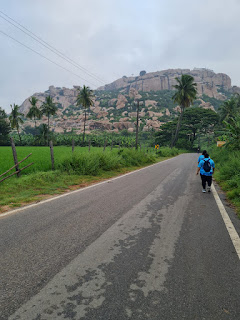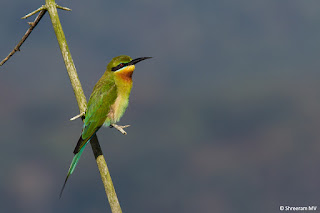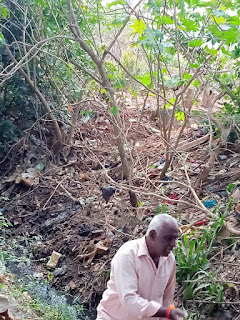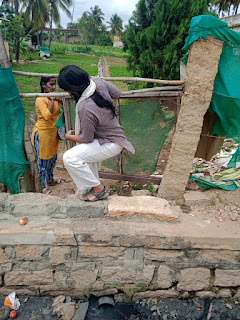Milestones:
a) Leaving RK and kids without a thought about how they will manage at home. Apparently, 11 year old Ani cooked dinner on night 1 and they all Swiggy-ed food on night 2. Really proud of my kiddos for being unfazed about cooking or keeping house! Maybe RK has the right attitude towards this after all: expect that kids (and people) will figure out how to take care of themselves, and they will!
b) Going for a sporting event with PCMH-MSCH junta: We have a lot in common, but it's usually not sports. So, I feel like I discovered a new facet to my friends and colleagues. We discuss health and fitness so much and it's nice to be able to practice what we preach. And we did it together, as we have done so many other difficult things together.
c) Cycling (almost) 40km: 21k from Kishkinda to Vittala, 4k inside Vittala temple complex, 9-10k on the way back, and about 5k to return the cycles. All in 1 day. If I could hug my legs and butt and tell them how proud I am of them, I would! Perhaps there is a yoga asana for this 😄
 |
Mr. Nagaraj, who biked down to Hampi from Belgaum in pouring rain at midnight, so he could be there at 4:30am to cheer and support the runners and cyclists. He took this pic
|
 |
| Prathamesh and I cycled, bird watched, explored the ruins of Vittala temple and encouraged each other. |
Others in the group did amazingly well too- some walked 10k and climbed the steep hill on Anjanadri (575 steps!)
 .
. 

|
| Not easy doing Anjeneyasana on a hard rock, but Poorva, Praneeth and Swaathi make it look effortless |
Ushnaa, the youngest (and clearly the fittest) of our group cycled 47km and ran 2km just for the heck of it. She's also the resident photographer extraordinaire:
d) Actively choosing to trust: leaping off a 15ft cliff into the Tungabhadra makes me realize how important it is to let go of control, and place trust in something or someone else. If Ani had not done the 20ft jump into the Kaveri a few months ago, when at BR Hills with Dr. Sudarshan, would I have had the courage to trust in my mentors, Mr. Kiran Betageri and Mr.Ravi, to do this?
What I am beginning to learn is that choosing to trust is a powerful act that enables greatness. I am so, so glad that I chose to jump and by doing so, shattered some mental beliefs of myself and created some new ones.
e) Gratitude for my body: I have such gratitude and pride for this outer covering that does so much for me. I have felt like this after breastfeeding my babies, probably hands-down the hardest thing I have ever done or will ever do.
Our religious texts and our society tells us not to take pride in our bodies, the latter from a sense of morality and shame, and the former from a viewpoint that the soul and the state of the soul takes precedence. In the Bhagvad Gita, the body is considered just the outer garment for the soul, something to be used and discarded in the soul's journey. This idea has given me intense comfort after the passing of my parents. It is the same I use when comforting those who have experienced the deaths of loved ones.

Yet, I treasure this outer garment and am grateful for the chance to strengthen it.
Update after discussion with RK:
The motto of the All India Institute of Medical Sciences (AIIMS) is "Sharīramādyam khalu dharmasādhanam" The body is the instrument of performing Dharma (doing the right thing). So, if you do not take care of your body, then how can you do anything else that is worth doing?
If I consistently underestimate the strength of my body, what else do I underestimate about myself and others, I wonder?
Here is a video of Kranthi, another chronic under-estimator of her own strength, who jumped 25ft without a life jacket, just because she knew she could and because she felt like it!
I'll end this post with a few pics of the amazing landscapes at Hampi. Until this trip, I had never appreciated it very much- always felt it was hot and crowded. But after this, it's become embedded into my mind and heart. After all, I have cycled its roads, I know its birds, I have discovered its hidden ponds behind hard rocks and I have seen its sunset and sunrise! Looking forward to returning with the man and kids... maybe we too will climb, cycle and dive together!
 |
| Sunrise at Sonapur Lake |
 |
| Sunset by the Virupaksha temple on the Tungabhadra. Just check out those sunrays... *feeling blessed* |
 |
| Our hotel rooms- cute or what? We are hobbitses! |
 |
View from Anjanadri- the birthplace of Hanuman
|
 |
This lot had an unending thirst for looking at old stone buildings. Thank God I was not with them!
 Banofee pie
Crispiest falafels ever had in India!
|
And finally, here's a (not comprehensive) list of birds and beasts seen:
a) Our ubiquitous bee-eater friend the little green bee-eater. I think we also saw blue-tailed (based on the length of the tail, not the color, since I didn't have my binos at the time)
Blue tailed bee-eater. Pic from eBird
Little green bee-eater. Pic from Wikimedia
See how similar looking they are?
b) White breasted kingfisher: found EVERYwhere, any little patch of water, be it in a paddy field or a pond, this little dude is sitting there waiting to catch his snack.
c) Southern grey shrikes, peacocks, egrets
d) Wire tailed swallows
These are the ones that do acrobatic flights, very commonly seen in evenings and early mornings. Check out the long wires at the tail that give it its name. Pic from Wikimedia.
e) White browed fantail: found in or near water bodies, happily catching insects. A friendly fellow, he shows off his plumage quite happily
pic from https://ebird.org/species/whbfan2
Also looks like this... much blacker than the one above. Pic from https://ebird.org/species/whbfan2
f) Lots of water birds:
- Painted storks (adults and juvvies),
- Cormorants
- Purple moorhens (in non-breeding plumage)
Adult and juvenile purple moorhen- we saw both at the pond near Sugriva's cave. Pic from http://www.oiseaux-birds.com/card-purple-swamphen.html
- Grey herons
Grey heron. Pic from https://www.flickr.com/photos/krishnacolor/50738727583
Grey heron in flight at sunset. Photo credit: Poorva Huilgol.
- Pond herons
- White ibis
- River terns (we saw one guy valiantly trying to catch fish at Sonapur Lake during our sunrise trip... he made multiple sallies, caught one, only to lose it a few seconds later as the fish slithered out of his grasp. Undaunted, he tried and tried again! Sonapur had LOTS of fish that kept leaping out and jumping ahead of the coracles, so hopefully he was successful!)
From https://ebird.org/species/rivter1
Distinguishing features: the black head, orange beak, forked tail and the boomerang shaped wings
g) Many bulbuls, including white browed, red vented and red whiskered
h) Hoopoe
On the way to Sugriva's cave
From https://ebird.org/species/hoopoe
h) Many butterflies: I'm still very much a novice when it comes to lepidoptery and find them way harder to identify than birds. But here are some of the ones we saw:
Blue tiger:
Tirumala limniace. Pic from Wiki media commons
Lesser grass blue
Pic from https://www.ifoundbutterflies.org/sp/829/Zizina-otis
Common grass yellow
Pic from Wiki media commons
And finally, some monkeys:
The usual bonnet macaques seen everywhere and most excitingly, the grey langur (also called Hanuman langur)
Pic from Wiki media commons
Finally, a shout-out to Kiran sir's Isuzu- is there anything more fun than clinging to the back of a pickup truck as it races over a highway at over a 100kph? At night? With the stars gleaming at you? Very little can top that experience in terms of sheer thrills, not even jumping down a 15ft cliff!
Pics not otherwise credited belong either to me or one of the following: Praneeth Pillala, Swaathi B. Ushnaa Kuri or Poorva Huilgol.



 Representation of pi, 1998, 2 years before her clinical symptoms
Representation of pi, 1998, 2 years before her clinical symptoms



































































